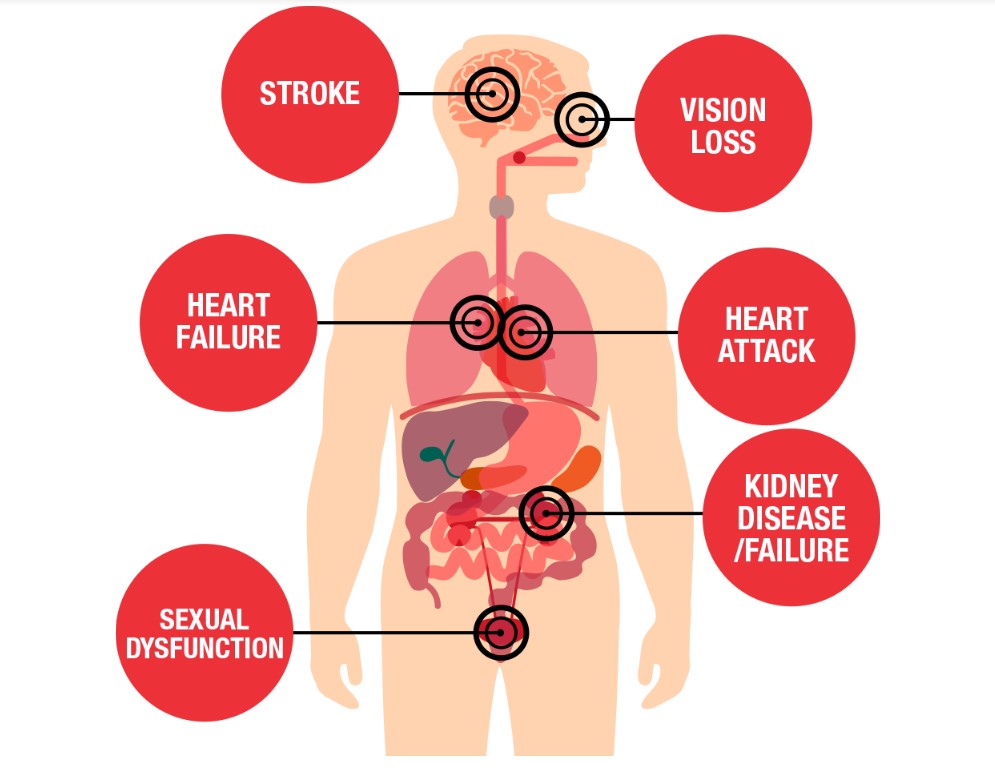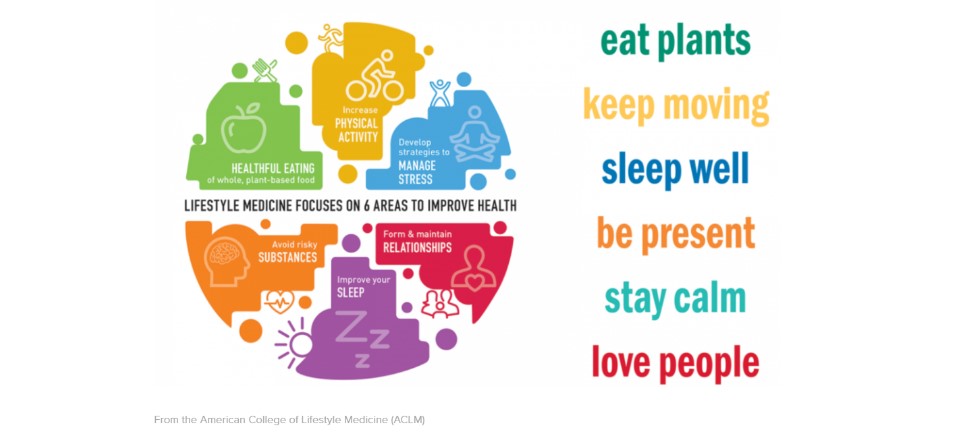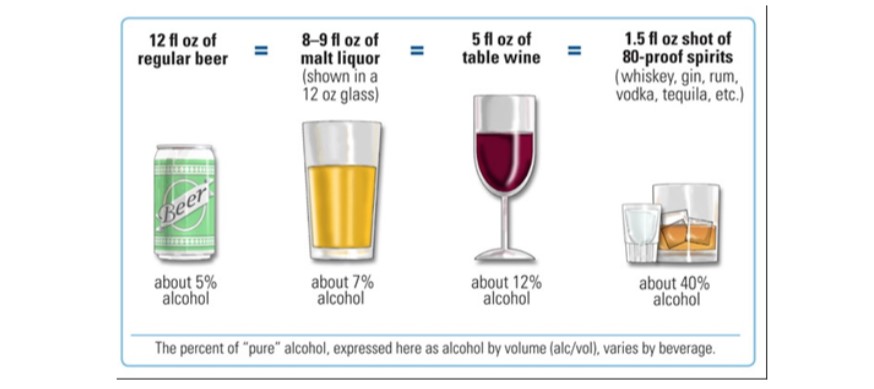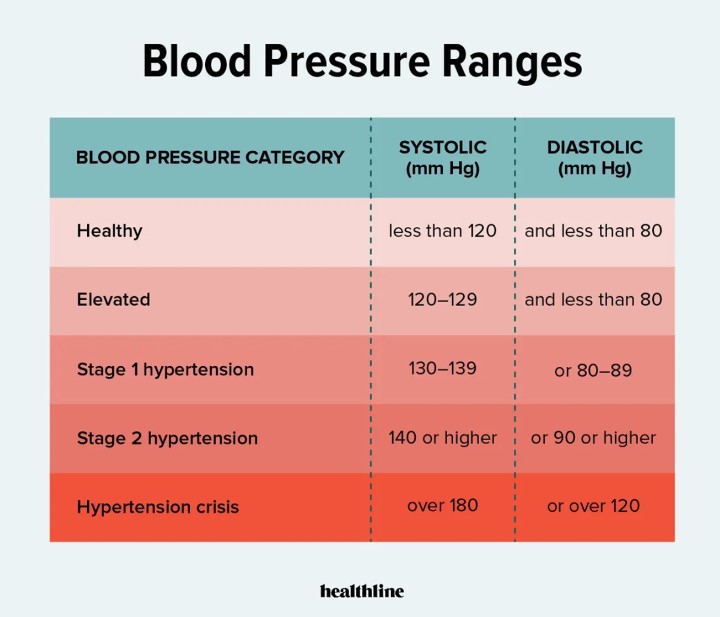May is National High Blood Pressure Education Month!
High Blood Pressure or Hypertension (HTN) is a common chronic medical condition, in which the pressure of blood in the arteries is persistently elevated. Most cases have no identifiable medical cause, lifestyle choices being the largest cause.
About 15% of deaths in men and 7% of deaths in women worldwide are attributable to hypertension [1]. Hypertension is often called “The Silent Killer” as often patients have no symptoms despite living with the disease for years until they develop consequences.

https://www.heart.org/en/health-topics/high-blood-pressure/health-threats-from-high-blood-pressure
I use Lifestyle Medicine, an evidence-based medical specialty, with a focus on six key lifestyle changes to treat many health problems, including high blood pressure (hypertension). These simple areas of focus as outlined below include changes we can all make to improve our health.

I want to share some attainable changes can help prevent hypertension from developing and reduce blood pressure WITHOUT the use of medications.
1) Dietary Changes:
Eat Plants – Did you know that only 7% of people who eat plant based diets (vegan) have hypertension, compared to 23% of non-vegetarians? [2] There are 30 + years of data from Lifestyle Medicine studies that say eating less processed foods and more plants in your diet improve health outcomes. Specifically diets diet rich in whole grains, fruits, vegetables and low-fat dairy products and low in saturated fat and cholesterol can lower high blood pressure by up to 11 mm Hg within two weeks! [3] Examples of eating plans that can help control blood pressure are the Dietary Approaches to Stop Hypertension (DASH) diet and the Mediterranean diet, both of which focus on minimally processed foods, with lots of leafy greens and fruits/veggies. [4]
Reduce salt (sodium) in your diet – Even a small reduction of sodium in the diet can improve heart health and reduce high blood pressure by about 5 to 6 mm Hg. The effect of sodium intake on blood pressure varies among groups of people. In general, limit sodium to 2,300 milligrams (mg) a day or less. However, a lower sodium intake — 1,500 mg a day or less — is ideal for most adults.
To reduce sodium in the diet:
1. Read food labels. Look for low-sodium versions of foods and beverages – these usually have less than 140mg of sodium PER SERVING. If there are more than 500mg of sodium per serving, this is a high sodium food.
2. Eat fewer processed foods. Only a small amount of sodium occurs naturally in foods. Most sodium is added during processing.
3. Don’t add salt. Use herbs or spices to add flavor to food.
4. Cook at home. Cooking lets you control the amount of sodium in the food. [4]
2) Keep Moving
∙Regular exercise – Physical in-activity is the fourth leading risk factor for global mortality and the number 1 cause of preventable deaths from all-cause mortality [5]. Regular physical activity can lower high blood pressure by about 5 to 8 mm Hg. It’s important to keep exercising to keep blood pressure from rising again. As a general goal, aim for at least 30 minutes of moderate physical activity every day [3]. However, there is no minimum threshold to see benefits and immediate results can be seen after single episodes of exercise. [6] Exercise can also help keep elevated blood pressure from turning into high blood pressure (hypertension). For those who have hypertension, regular physical activity can bring blood pressure down to safer levels.
Some examples of aerobic exercise that can help lower blood pressure include walking, jogging, cycling, swimming or dancing. Another possibility is high-intensity interval training. This type of training involves alternating short bursts of intense activity with periods of lighter activity.
Strength training also can help reduce blood pressure. Aim to include strength training exercises at least two days a week. Talk to a health care provider about developing an exercise program. [4]
Lose extra pounds and watch your waistline – Blood pressure often increases as weight
increases. Being overweight also can cause disrupted breathing while you sleep (sleep apnea),
which further raises blood pressure.
Weight loss is one of the most effective lifestyle changes for controlling blood pressure. If you’re overweight or have obesity, losing even a small amount of weight can help reduce blood pressure. In general, blood pressure might go down by about 1 millimeter of mercury (mm Hg) with each kilogram (about 2.2 pounds) of weight lost.
Also, the size of the waistline is important. Carrying too much weight around the waist can increase the risk of high blood pressure. In general:
o Men are at risk if their waist measurement is greater than 40 inches (102 centimeters).
o Women are at risk if their waist measurement is greater than 35 inches (89 centimeters).
These numbers vary among ethnic groups. [4]
3) Sleep Well
Poor sleep quality — getting fewer than six hours of sleep every night for several weeks — can contribute to hypertension. A number of issues can disrupt sleep, including sleep apnea, restless leg syndrome and general sleeplessness (insomnia).
Let your health care provider know if you often have trouble sleeping. Finding and treating the cause can help improve sleep. However, if you don’t have sleep apnea or restless leg syndrome, follow these simple tips for getting more restful sleep.
Stick to a sleep schedule. Go to bed and wake up the same time each day. Try to keep the same schedule on weeknights and on weekends.
Create a restful space. That means keeping the sleeping space cool, quiet and dark. Do something relaxing in the hour before bedtime. That might include taking a warm bath or doing relaxation exercises. Avoid bright light, such as from a TV or computer screen.
Watch what you eat and drink. Don’t go to bed hungry or stuffed. Avoid large meals close to bedtime. Limit or avoid nicotine, caffeine and alcohol close to bedtime, as well.
Limit naps. For those who find napping during the day helpful, limiting naps to 30 minutes earlier in the day might help nighttime sleep. [4]
4) Avoid Toxins
Limit alcohol: Drinking too much alcohol can raise blood pressure by several points. It can also reduce the effectiveness of blood pressure medications. Limiting alcohol to less than one drink a day for women or two drinks a day for men can help lower blood pressure by about 4 mm Hg. [4] See the graph below for the formal definition of “One drink” – it varies by alcohol type and strength (12 ounces of beer, 5 ounces of wine or 1.5 ounces of 80-proof liquor) [7]

Photo credit: Standard drink – Wikipedia – https://en.wikipedia.org/wiki/Standard_drink
Quit smoking: Smoking increases blood pressure. Stopping smoking helps lower blood pressure. It can also reduce the risk of heart disease and improve overall health, within the first year after quitting, possibly leading to a longer life. [3,8]
5) Be Present/Stay Calm
Reduce stress: Long-term (chronic) emotional stress may contribute to high blood pressure. When people are stressed, they are less likely to engage in healthy habits [9]. The good news is stress can be treated!
First, reflect and determine what causes your stress, such as work, family, finances or illness, and find ways to reduce stress. Some options are:
Avoid trying to do too much. Plan your day and focus on your priorities. Learn to say no. Allow enough time to get done what needs to be done.
Focus on issues you can control and make plans to solve them. For an issue at work, talk to a supervisor. For conflict with kids or spouse, find ways to resolve it.
Avoid stress triggers. For example, if rush-hour traffic causes stress, travel at a different time or take public transportation. Avoid people who cause stress if possible.
Make time to relax. Take time each day to sit quietly and breathe deeply. Make time for enjoyable activities or hobbies, such as taking a walk, cooking or volunteering.
Practice gratitude. Expressing gratitude to others can help reduce stress [4]
6) Love People
Get support: Supportive family and friends are important to good health. Something as simple as petting an animal or hugging a loved one has been shown to reduce blood pressure. Your support system often encourages you to take care of yourself, drive you to the care provider’s office or start an exercise program with you to keep your blood pressure low.
If you find you need support beyond your family and friends, consider joining a support group. This may put you in touch with people who can give you an emotional or morale boost and who can offer practical tips to cope with your condition. [4]
References:
1) Blair, SN. Physical inactivity, the biggest public health problem of the 21 st century. British Journal of Sports Medicine, 2009, 43(1): p.1-2
2) Orlich, MJ and GE Fraser, Vegetarian diets in the Adventist Health Study 2: a review of initial published findings. Am J Clin Nutr, 2014. 100 Suppl 1:p. 353z-8
3) Peterson, BJ, et. Al. Vegetarian diets and blood pressure among white subjects: results from the Adventist Health Study-2 (AHS-2). Public Health Nutr. 2012. 15(10): p1909-16
4) Mayo Clinic 10 ways to control high blood pressure without medication https://www.mayoclinic.org/diseases-conditions/high-blood-pressure/in-depth/high-blood-pressure/art-20046974
5) WHO. Global Health Risks: Mortality and burden of disease attributable, to selected major risks. 2009
6) ODDHP. 2018 Physical Activity Guidelines Advisory Committee Scientific Reports. Health.gov. 2018
7) Standard Drink Image – Wikipedia – https://en.wikipedia.org/wiki/Standard_drink
8) WHO. Fact sheet about health benefits of smoking cessation, Available from: https://who.int/tobacco/quitting/en_tfi_wuitting_fact_sheet.pdf.
9) APA. Key Findings Stress in America. 2010 https://apa.org/news/presss/releases/stress/2010/key-findings.aspx




